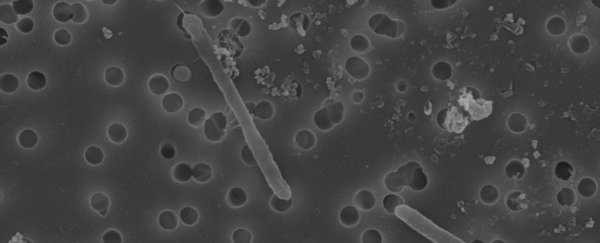A bacterium that dwells deep underground, living off chemical reactions triggered by radioactive decay, has been doing so unchanged for millions of years, new research has found.
A genetic analysis of microbes of the species Candidatus Desulforudis audaxviator (CDA) collected from three different continents has revealed that the bacterium has barely evolved since they were last together on the same land mass, Pangaea.
That means they have been in what scientists call 'evolutionary stasis' for at least 175 million years, making CDA the only known subterranean living microbial fossil. This could have important implications for our understanding of microbial evolution.
"This discovery shows that we must be careful when making assumptions about the speed of evolution and how we interpret the tree of life," said microbiologist Eric Becraft of the University of North Alabama.
"It is possible that some organisms go into an evolutionary full-sprint, while others slow to a crawl, challenging the establishment of reliable molecular timelines."
CDA is a peculiar little organism. It was first discovered in 2008, living 2.8 kilometers (1.7 miles) below Earth's surface, in the groundwater of a gold mine in South Africa. Moreover, it comprised 99.9 percent of the microorganisms in the place it was found - effectively constituting a single-species ecosystem.
This, as you can imagine, is pretty rare. The tiny microbes live in water-filled cavities on the rock, relying on chemosynthesis for food; unlike photosynthesis, which relies on sunlight for conversion into energy, chemosynthetic organisms derive their energy from chemical reactions.
In the case of CDA, it's the decomposition of water molecules due to the ionizing radiation generated by the radioactive decay of uranium, potassium and thorium.
Therefore, unlike the majority of life on Earth, the bacterium doesn't rely on either sunlight or other organisms for its survival - it can just keep on keepin' on, down there in the soggy dark.
The team wanted to learn more about CDA and how it has evolved and adapted, so they searched samples of deep groundwater from other continents, and found the bacterium in Siberia and California, and other locations in South Africa.
They collected 126 microbes from all three continents, and - being extremely careful, with investigators from each laboratory not going near the others - sequenced their genomes. They thought that, by comparing the microbes from separate continents, in differing physicochemical environments, they would see the ways in which they had evolved and diversified as they each adapted to their particular circumstances.
"We wanted to use that information to understand how they evolved and what kind of environmental conditions lead to what kind of genetic adaptations," said microbiologist Ramunas Stepanauskas of Bigelow Laboratory for Ocean Sciences in Maine.
"We thought of the microbes as though they were inhabitants of isolated islands, like the finches that Darwin studied in the Galapagos."
They had no reason not to believe this - how could a microbe isolated 3 kilometers below ground in South Africa possibly have contact with a microbe isolated 3 kilometers below ground in Siberia? Yet, when the team compared the genomes, they found that the microbes on the three continents were almost identical.
Closer investigation revealed no evidence that CDA can survive on the surface, or in the air, never mind travel vast distances, and they double-checked that there had been no cross contamination of the samples. Once these were all ruled out, the researchers had to find a different answer.
The most plausible explanation? The microbes have barely evolved.
"The best explanation we have at the moment is that these microbes did not change much since their physical locations separated during the breakup of supercontinent Pangaea, about 175 million years ago," Stepanauskas said.
"They appear to be living fossils from those days. That sounds quite crazy and goes against the contemporary understanding of microbial evolution."
We know that bacteria can evolve extremely rapidly; in fact, this has been a huge problem in developing antibiotic drugs, since some microbes have been able to evolve resistance to these drugs. We don't really hear about the opposite scenario, though. Some scientists have suggested some cyanobacteria species may be in a state of evolutionary stasis, although that has been disputed.
CDA could be the best case yet for evolutionary stasis in a microbe. The team believes it could be because the microbes have specialized mechanisms that help them resist mutation. The researchers identified genes for DNA repair mechanisms that could reduce mutation rates, along with polymerase - the enzymes that put together the long chains of genetic material - that has a better accuracy than seen in some other organisms.
This has potential applications in biotechnology, from diagnostic tests to gene therapy, the scientists said. Beyond how we can use it for our own benefit, though, the finding shows us just how little we don't know about our strange, wonderful, diverse planet.
"These findings are a powerful reminder that the various microbial branches we observe on the tree of life may differ vastly in the time since their last common ancestor," Becraft said.
"Understanding this is critical to understanding the history of life on Earth."
The research has been published in The ISME Journal.
